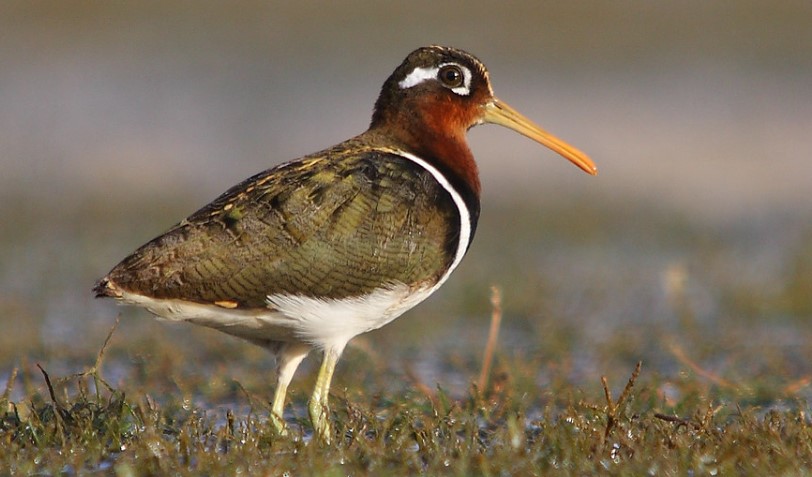The Painted Snipe (Rostratula benghalensis) is a brilliantly patterned bird with wings that are marked like the wings of a huge butterfly. It is rarely seen and is often regarded as a rare bird species because of its cryptic appearance. Observed from above, the birds are dark and blend in with their surroundings.
However, if you were to look at them from the side, their alternating dark and light plumage would make them look camouflaged, as it breaks up their body outline. It is also believed that they are more active at night than during the day and that they inhabit swampy areas that are difficult to reach, and perhaps that, in turn, could explain why there are so few records of their presence. In the southern part of their range, Painted Snipe prefer shallow freshwater swamps, and in the northern part, they prefer salt marshes, where they eat samphire, which is a succulent herb.
The birds move away from an area when it begins to dry up, becomes flooded, or becomes too cold for them. It is most likely that they will be active at night, during dawn, and at dusk. During the day, they sit quietly under reeds or grasses and wait for the sun to rise. Their diet generally includes aquatic insects, grasshoppers, crickets, earthworms, and some plant seeds, which they eat while skulking along like a rail, most of the time living alone.

There is a special adaptation in the bill that makes it suitable for probing in soft mud. Painted snipes play an unusual role when it comes to gender roles. Generally, the females are more brightly colored, initiate courtship, and mate with any male they find available at the time. As soon as the young hatch, they are covered with dense down and are able to run about, swim, and pick up the food themselves as soon as the male builds the nest, incubates the eggs, and raises the young.
The female, meanwhile, can find another itinerant mate at her leisure. When cornered, the Painted Snipe displays an impressive defense display. Fanning out its wings and tail, it presents a body area four times its normal size, hisses like a snake, and growls like a dog when threatened. When disturbed, birds will ‘freeze’ in whatever attitude they have. When alerted, birds ‘tail bob’ by dipping their tails.
In length, the male bird measures 220 mm, and the female measures 250 mm. A male resembles a female but is duller. There is gray-brown mottling all over the head and neck, as well as a buff stripe running through the eyes and across the crown. Black, buff, and white bars on the wings and back. There is a broad band of black on the breast. The upper wing coverts of a female are spotted buff. The head, neck, upper breast, and back are chestnut-bronze in color. There is a conspicuous buff ‘V’ in the center of the back.
Its wings are metallic bronze-green with bands of black, buff, and chestnut on the flight feathers. The upper coverts of the wings are finely barred, and their scapulars conceal long, pure white feathers. There is a broad white band between the neck and wings; there is a buff central streak down the crown; and there is a broad horizontal white band through the eye. There is a white color on the belly and vent. Brown is the color of the eyes. There is a long, pink-orange bill that darkens towards the tip as it gets closer to the tip. A bluish-green color can be seen on the feet and legs. It is similar to that of a male. However, it lacks the continuous black band on the lower breast that characterizes males. The downy Young is a fawn-colored cat with a black stripe above and a tan stripe in the middle.
It is common for females to growl like dogs when threatened. The females also hiss like snakes when threatened. There is also a sharp, repeated alarm call: cuck-cuck. A soft click-click call also produced by the male near the nest.
There is a nesting and breeding season in the south between October and December, and in the north between March and May, where small colonies are found. The nest itself is typically 15 cm in diameter, erected in a mud pit with shallow water surrounding it, and somewhat sheltered. It is lined with grass, reeds, and roots to create a basic platform.
Usually, Painted Snipes lay four glossy white eggs, light buff, heavily splotched with olive and slate grey; pyriform, and about 36 x 25 mm in size. The incubation period is between 19-20 days, conducted by males.
Painted Snipe inhabits muddy, freshwater swamps in the Murray-Darling and Great Artesian basins in eastern and northern Australia. There are numerous Pacific islands, Indonesia, Asia, and Africa where these animals live as nomads. Only one race is found in Australia, but there are two races worldwide.
Read More: Red-backed Button-quail (Turnix maculosa)







